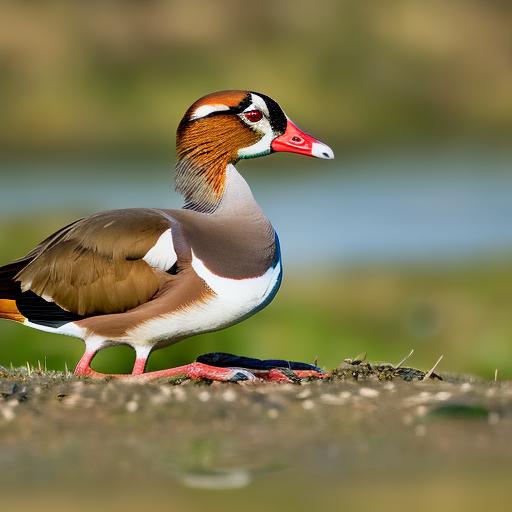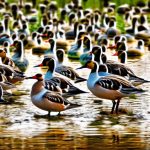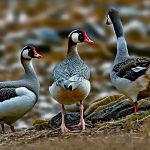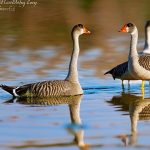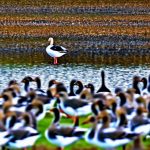The Egyptian goose, also known as Alopochen aegyptiaca, is a species of waterfowl that is native to Africa. These striking birds are easily recognizable by their distinctive markings, which include a chestnut brown body, a white wing patch, and a dark brown eye patch. They are also known for their loud, honking calls, which can often be heard echoing across the wetlands and grasslands where they make their homes.
Egyptian geese are highly adaptable birds and can be found in a wide range of habitats, including rivers, lakes, marshes, and even urban areas. They are also known for their strong pair bonds and are often seen in pairs or small family groups. These birds are not migratory and tend to stay in the same area year-round, making them a familiar sight to many people in their native range.
The Life Cycle of Egyptian Geese
The life cycle of the Egyptian goose begins with the breeding season, which typically occurs in the spring. During this time, pairs of geese will engage in elaborate courtship displays, which can include head bobbing, wing flapping, and honking calls. Once a pair has formed, they will begin to search for a suitable nesting site, which is typically located near water and provides good visibility of the surrounding area.
After finding a suitable location, the female will begin to construct the nest using grasses, reeds, and other plant materials. Once the nest is complete, she will lay a clutch of eggs, which can range in number from 5 to 12. The eggs are an olive green color and are incubated by both parents for around 28 days. Once the eggs hatch, the goslings are precocial, meaning they are able to leave the nest and feed themselves shortly after hatching. The parents will continue to care for and protect the goslings until they are old enough to fend for themselves.
Nesting and Mating Habits of Egyptian Geese
The nesting and mating habits of Egyptian geese are fascinating to observe. These birds are known for their strong pair bonds, and once a pair has formed, they will often stay together for life. During the breeding season, pairs of geese will engage in elaborate courtship displays, which can include head bobbing, wing flapping, and honking calls. These displays are not only a way for the geese to bond with each other, but also to establish their territory and deter potential rivals.
Once a pair has formed, they will begin to search for a suitable nesting site, which is typically located near water and provides good visibility of the surrounding area. The female will then construct the nest using grasses, reeds, and other plant materials, creating a shallow depression in the ground lined with soft materials. The male will often stand guard nearby, keeping a lookout for potential threats while the female is busy building the nest. Once the nest is complete, the female will lay a clutch of eggs, which are incubated by both parents for around 28 days.
The Importance of Wetlands for Egyptian Geese Breeding
Wetlands play a crucial role in the breeding success of Egyptian geese. These birds are highly dependent on wetland habitats for nesting, feeding, and raising their young. Wetlands provide a rich source of food for the geese, including aquatic plants, invertebrates, and small fish. They also offer protection from predators and provide a safe and secure environment for the geese to raise their young.
In addition to providing food and shelter, wetlands also play a key role in the courtship and mating behaviors of Egyptian geese. These birds are often seen engaging in elaborate courtship displays near water, using their surroundings to establish their territory and attract a mate. Without access to suitable wetland habitats, the breeding success of Egyptian geese would be greatly compromised, making the conservation and preservation of wetlands essential for the long-term survival of these birds.
The Role of Egyptian Geese in Ecosystems
Egyptian geese play a vital role in the ecosystems where they make their homes. As herbivorous waterfowl, they help to control the growth of aquatic plants by grazing on them, preventing overgrowth and maintaining a healthy balance in wetland habitats. They also consume a variety of invertebrates, including insects and snails, which helps to regulate populations and prevent outbreaks of pests.
In addition to their role as herbivores, Egyptian geese also serve as prey for a variety of predators, including large birds of prey, mammals, and reptiles. By providing a food source for these predators, the geese help to support the overall biodiversity of their ecosystems. Their presence also contributes to the nutrient cycling of wetland habitats, as their droppings provide valuable nutrients for plants and other organisms.
The Challenges of Egyptian Geese Breeding
Despite their adaptability and resilience, Egyptian geese face a number of challenges when it comes to breeding. One of the biggest threats to their breeding success is habitat loss and degradation. Wetlands, which are crucial for the geese to nest and raise their young, are under increasing pressure from human development, pollution, and climate change. As wetlands disappear or become degraded, the availability of suitable breeding habitat for Egyptian geese is greatly reduced, leading to declines in their populations.
In addition to habitat loss, Egyptian geese also face threats from predation, competition with other waterfowl species, and human disturbance. Predators such as foxes, raccoons, and birds of prey can pose a significant risk to nesting geese and their young, while competition for resources with other waterfowl species can limit the availability of suitable nesting sites and food. Human disturbance, including recreational activities such as boating, fishing, and hunting, can also disrupt the breeding behaviors of Egyptian geese, leading to lower breeding success and reduced populations.
Egyptian Geese Parenting and Nest Protection
Once the eggs have hatched, the parents will continue to care for and protect the goslings until they are old enough to fend for themselves. The goslings are precocial, meaning they are able to leave the nest and feed themselves shortly after hatching, but they still rely on their parents for protection and guidance. The parents will lead the goslings to suitable feeding areas, teaching them how to find and consume food, and keeping a close watch for potential threats.
One of the most important roles of the parents is to protect the goslings from predators. Egyptian geese are highly vigilant and will aggressively defend their young from any potential threats, including other birds, mammals, and humans. They will use a variety of vocalizations and displays to deter predators, and will not hesitate to physically attack if necessary. The parents will also lead the goslings to safety if they sense danger, using their knowledge of the surrounding area to find suitable hiding spots or escape routes.
The Behavior of Egyptian Goslings
The behavior of Egyptian goslings is fascinating to observe. These young birds are highly curious and energetic, and will often be seen exploring their surroundings, playing with each other, and learning important life skills from their parents. They are also highly social and will form close bonds with their siblings and parents, often staying close together as a group.
As they grow, the goslings will begin to develop their flying abilities, practicing short flights and honing their skills in preparation for their first migration. They will also learn important foraging behaviors from their parents, including how to find and consume a variety of food sources. The parents will continue to provide guidance and protection for the goslings until they are old enough to fend for themselves, at which point they will leave the family group and strike out on their own.
Human Impact on Egyptian Geese Breeding
Human activities have a significant impact on the breeding success of Egyptian geese. Habitat loss and degradation, caused by urban development, agriculture, and pollution, are major threats to the availability of suitable nesting sites and food sources for the geese. Wetlands, in particular, are under increasing pressure from human activities, leading to declines in the populations of Egyptian geese and other waterfowl species.
In addition to habitat loss, human disturbance can also disrupt the breeding behaviors of Egyptian geese. Recreational activities such as boating, fishing, and hunting can cause stress and disturbance to nesting geese, leading to lower breeding success and reduced populations. Pollution from agricultural runoff, industrial waste, and litter can also have negative impacts on wetland habitats, affecting the availability of food and water for the geese.
Conservation Efforts for Egyptian Geese
Conservation efforts for Egyptian geese are crucial for the long-term survival of these birds. One of the most important steps in conserving Egyptian geese is the protection and restoration of wetland habitats. This can be achieved through the creation of protected areas, such as national parks and wildlife reserves, as well as the implementation of sustainable land management practices that prioritize the conservation of wetlands.
In addition to habitat protection, conservation efforts for Egyptian geese also include the monitoring of populations, research into their breeding behaviors and ecology, and the development of management plans that aim to mitigate the impacts of human activities on the geese. Public education and outreach programs can also play a key role in raising awareness about the importance of wetlands and the need to conserve Egyptian geese and other waterfowl species.
Overall, the conservation of Egyptian geese requires a multi-faceted approach that addresses the various threats they face, including habitat loss, human disturbance, and predation. By working together to protect wetland habitats and raise awareness about the importance of these birds, we can ensure that Egyptian geese continue to thrive in their native range for generations to come.
Meet Walter, the feathered-friend fanatic of Florida! Nestled in the sunshine state, Walter struts through life with his feathered companions, clucking his way to happiness. With a coop that’s fancier than a five-star hotel, he’s the Don Juan of the chicken world. When he’s not teaching his hens to do the cha-cha, you’ll find him in a heated debate with his prized rooster, Sir Clucks-a-Lot. Walter’s poultry passion is no yolk; he’s the sunny-side-up guy you never knew you needed in your flock of friends!

